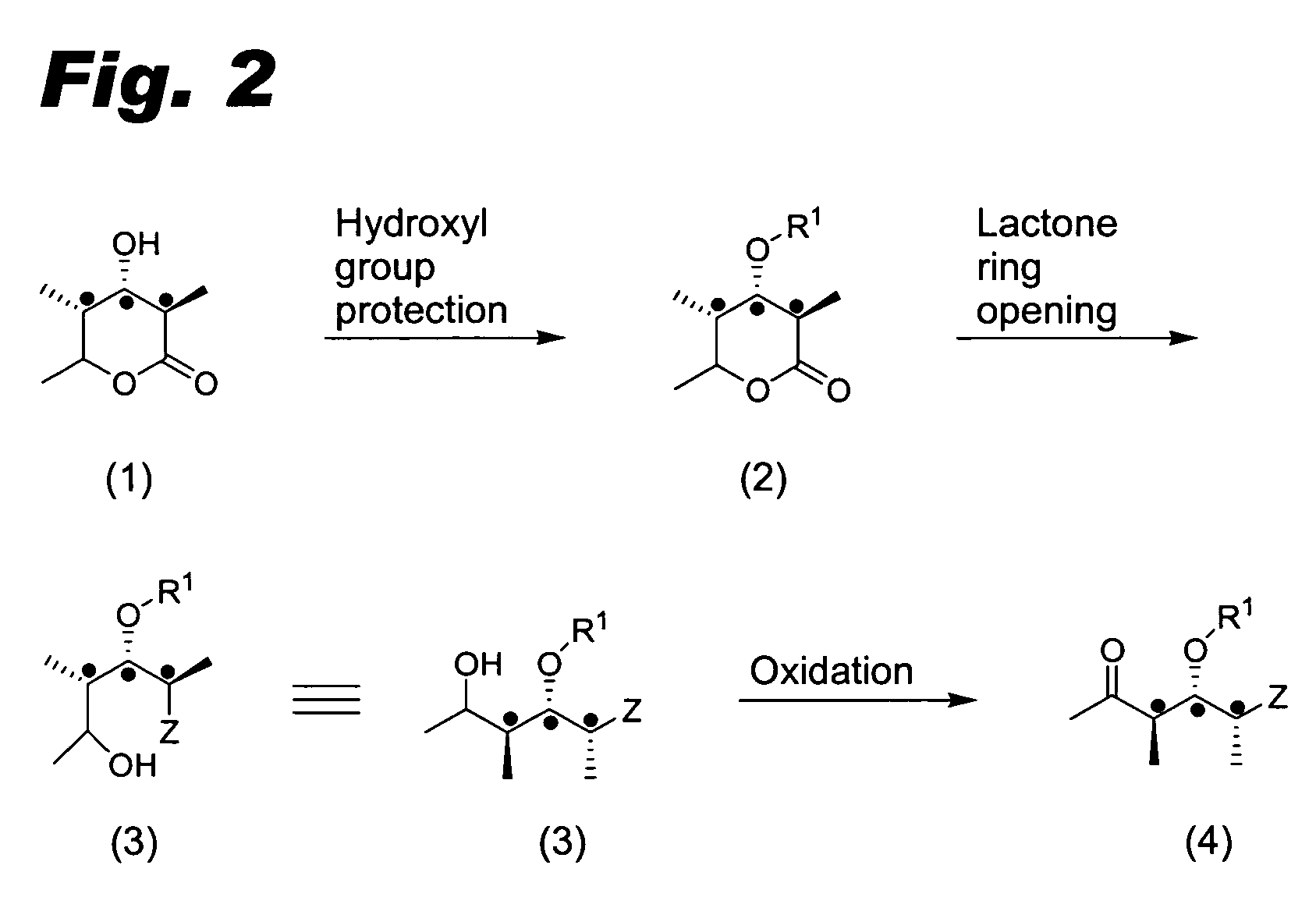Compounds useful for the synthesis of (+)-discodermolide and methods thereof
a technology of discodermolide and compounds, applied in the field of compounds useful for the synthesis of (+)discodermolide, can solve the problems of inability to isolate and culture the symbiont, inability to achieve such an approach, and inability to meet the requirements of synthesis
- Summary
- Abstract
- Description
- Claims
- Application Information
AI Technical Summary
Benefits of technology
Problems solved by technology
Method used
Image
Examples
example 1
Hydroxy Lactone 1
[0109]
[0110]Hydroxy lactone 1 in the absolute stereochemistry of structure 1a can be produced by the fermentations of bioengineered polyketide-producing microorganisms. See, for example, Khosla et al., U.S. Pat. No. 5,712,146 (1998); Khosla et al., U.S. Pat. No. 6,531,299 B1 (2003); Khosla et al., U.S. Pat. No. 6,558,942 B1 (2003); Brown et al., J. Chem. Soc. Chem. Comm., 1995, 1517-1518; Kao et al., J. Am. Chem. Soc., 117, 9105-9106 (1995); Pieper et al., J. Am. Chem. Soc., 117, 11373-11374 (1995); Weissman et al., Chemistry & Biology, 5 (12), 743-754 (1998); Rowe et al., Chemistry & Biology, 8, 475-485 (2001); and Kim et al., Biochemistry 41, 10827-10833 (2002); the disclosures of which are incorporated herein by reference.
[0111]Hydroxy lactone 1 in the absolute stereochemistry of structure 1b can be produced by chemical synthesis: Brooks et al., Tetrahedron Lett., 23 (48), 4991-4994 (1982), the disclosure of which is incorporated by reference.
example 2
Hydroxy-Protected Lactone 2b
[0112]
[0113]To a solution of hydroxy lactone 1a (0.090 g, 0.577 mmol, 1 eq) in N,N-dimethylformamide (“DMF,” 5.0 mL) was added imidazole (0.098 g, 1.442 mmol, 2.5 eq) followed by tert-butyldimethylsilyl chloride (0.130 g, 0.865 mmol, 1.2 eq). After stirring at room temperature for 18 hours, the solution was partitioned between aqueous sodium bicarbonate (15 mL) and ethyl acetate (20 mL). The organics were further washed with aqueous ammonium chloride (15 mL), water (15 mL) and brine (15 mL) before drying (sodium sulfate) and concentrating under reduced pressure. Column chromatography (silica, 15% ethyl acetate-hexane) yielded hydroxy-protected lactone 2b (0.094 g, 61%) as a colorless oil: 1H (400 MHz) δ 4.43 (1H, qd, J 6.5, 2.5 Hz, H-5), 3.73 (1H, dd, J 10.0, 4.0 Hz, H-3), 2.44 (1H, dq, J 9.5, 7.0 Hz, H-2), 1.97-1.94 (1H, m, H-4), 1.34 (3H, d, J 7.0 Hz, H-2′ or H-6), 1.32 (3H, d, J 7.0 Hz, H-2′ or H-6), 0.96 (3H, d, J 7.0 Hz, H-4′), 0.91 (9H, s, SiC(CH3)3...
example 3
Alcohol 3b
[0114]
[0115]To a suspension of N,O-dimethylhydroxylamine hydrochloride (0.054 g, 0.556 mmol, 3.0 eq) in tetrahydrofuran (“THF,” 1.0 mL) at 0° C. was added trimethylaluminum (0.25 mL of a 2.2M solution, 0.556 mmol, 3.0 eq). The mixture was warmed to room temperature and stirred for 40 minutes before cooling to 0° C. and adding a solution of hydroxy-protected lactone 2b (0.050 g, 0.185 mmol, 1.0 eq) in THF (1.0 mL). The resulting solution was stirred at 0° C. for 1 hour and at room temperature for 1.5 hours before quenching with water (1 mL). The mixture was partitioned between dichloromethane (15 mL) and water-aqueous sodium bicarbonate (1:1, 10 mL). The aqueous phase was extracted with dichloromethane (3×10 mL) and the combined organics dried (sodium sulfate) before concentrating under reduced pressure to yield the crude alcohol 3b, which was used without further purification; 1H (400 MHz) δ 4.37 (1H, q, J 7.0 Hz, H-5), 4.00 (1H, d, J 9.0 Hz, H-3), 3.70 (3H, s, NOCH3), 3.3...
PUM
| Property | Measurement | Unit |
|---|---|---|
| temperature | aaaaa | aaaaa |
| temperature | aaaaa | aaaaa |
| structure | aaaaa | aaaaa |
Abstract
Description
Claims
Application Information
 Login to View More
Login to View More - R&D
- Intellectual Property
- Life Sciences
- Materials
- Tech Scout
- Unparalleled Data Quality
- Higher Quality Content
- 60% Fewer Hallucinations
Browse by: Latest US Patents, China's latest patents, Technical Efficacy Thesaurus, Application Domain, Technology Topic, Popular Technical Reports.
© 2025 PatSnap. All rights reserved.Legal|Privacy policy|Modern Slavery Act Transparency Statement|Sitemap|About US| Contact US: help@patsnap.com



